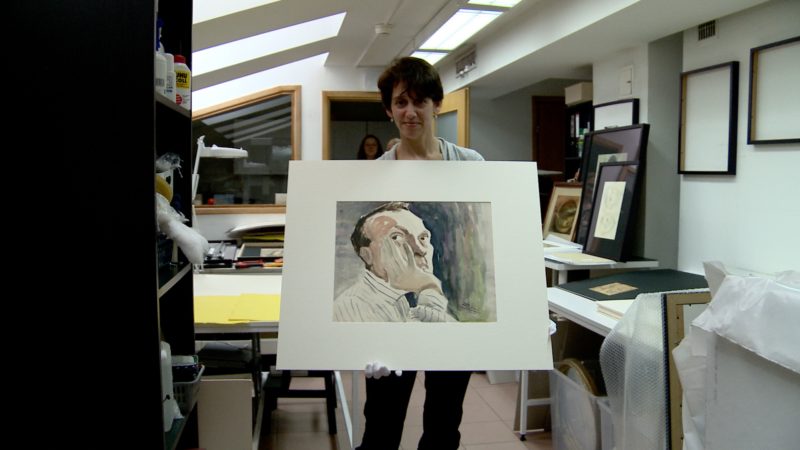Making the rounds of Jewish film festivals across the country is the documentary Chasing Portraits by Elizabeth Rynecki, concerning a quest to learn more about the pre-Holocaust art of her Polish Jewish great-grandfather Moshe Rynecki (Pronounced Renetsky). Previously, Elizabeth Rynecki published a book with the same title that detailed her research.
The artist was removed from the Warsaw Ghetto to the Majdanek Concentration Camp, where he was murdered by the Nazis. However, many of his paintings of Jewish life—both in the cities and in the shtetls—have been preserved. Elizabeth Rynecki’s father, Alex, owns approximately 120 of his grandfather’s paintings, and another 52 paintings are at the Jewish Historical Institute in Poland. Beyond that, there are small collections in other Polish museums, as well as another in the collection of Yad Vashem in Israel.
Because the paintings are so evocative, they are of interest not only as art objects, but also as testaments to a bygone era. In the documentary, we see images of a Jewish wedding, a pogrom, a carnival, tailors cutting and sewing, cobblers making shoes, a blacksmith at his forge, men sitting on park benches, probably kibitzing. Moshe Rynecki had a distinctive style.
The 74-minute film shows a representative number of the 200 or so paintings by Rynecki that still exist from a body of work that exceeded over 800 works. It also documents the Rynecki family’s efforts to recover their past. Elizabeth’s efforts to learn what happened to her great-grandfather’s paintings takes her—and us, the viewers—to Toronto, Canada; Warsaw, Poland; the Majdanek Concentration Camp in Poland; Jerusalem and Tel Aviv, Israel; and in the United States both New York City, and her father’s home near Eureka, California..
Her father, Alex, was a child when the family arrived in the United States so his memories of the Holocaust are for the most part second hand, although he does recall being forced with his family to travel from place to place, cautiously bringing food with them to ward off starvation. Unlike Elizabeth’s great-grandfather Moshe, who chose to remain in the Warsaw ghetto, her grandfather George had forged identity papers that enabled his family to pose as Christians—a disguise they were able to maintain throughout the war.
In Poland, Moshe and Perla Rynecki had lived in a building in which an art supply store was on the bottom floor, and their home and his studio were above. Following the war, Moshe’s wife, Perla, recovered many of the paintings from hiding places that Moshe had previously revealed to her.
In Toronto, Elizabeth met Moshe Wertheim, who owned four of her great-grandfather’s paintings. Wertheim said that his parents were returning from Russia to Poland after the war, when they met a Polish farmer who said that he had found paintings of Jewish interest that he was willing to sell. Mr. Wertheim had no idea how much they paid, or where in Poland they met that farmer.
Wertheim told Elizabeth that his brother in Poland had two other pieces of art by her great-grandfather. She decided to travel to Poland, not only to see Alex Wertheim’s paintings, but those lodged at the various museums, In Poland, Alex told a different story about how their parents obtained the Rynecki paintings. He said the paintings had been on a train that was bombed, and that villagers subsequently looted the paintings and other objects of value. At some point, his father purchased 50 paintings, dispensing them over the years as gifts to many different people, among whom was a cousin who lived in Israel.
That prompted Elizabeth to arrange a visit to Israel, hoping to see the eight paintings which the elderly cousin reportedly possessed. However, the cousin refused to meet with her, or even to send her photos of the paintings. This frustrated Elizabeth greatly, almost to the point of bringing suit against the elderly woman. Eventually, Elizabeth decided for the sake of shalom bayit (peace in the house) not to pursue any action. She believed neither her great-grandfather nor her grandfather would have wanted her and her fellow Jews to quarrel over ownership of the paintings.
Contrasting with the selfishness of the unnamed elderly woman in Israel was the generosity of private art collector Edward Napiorkowski, whose home was filled with art of both Jewish and Christian origin. The Rynecki piece in his collection showed happy people playing with a beach ball. On the spur of the moment, he decided to make a gift of the painting to Elizabeth, who immediately began to cry. As she explained, Edward felt that her family had suffered losses, and he wanted to do what he could, however small, to symbolically repair some of that loss. “That was not a moment I could have imagined,” she said as the director of photography, Slawomir Grunberg, caught the touching scene.
The discussions that Elizabeth had with museum curators in Poland and in Israel were interesting, stressing the importance of Rynecki’s work being held in permanent collections at a time when the number of Holocaust survivors is radically diminishing throughout the world. As illustrated by the differing accounts given by the Wertheim brothers of how six paintings came into their family’s hands, establishing the provenance of art that somehow survived the Holocaust is a tricky, and touchy, business. Elizabeth made it a point to tell the Polish museum curators that she was visiting them in the capacity of a historian, not as a claimant.
Elizabeth’s silent walk through Majdanek, where her great-grandfather was killed, was among the more poignant moments of the documentary.
Chasing Portraits was shown March 10 at the Sacramento Jewish Film Festival, and is scheduled to be shown at Jewish film festivals in Palm Springs March 24; Springfield, Massachusetts March 29; and Marblehead, Massachusetts April 29.


























